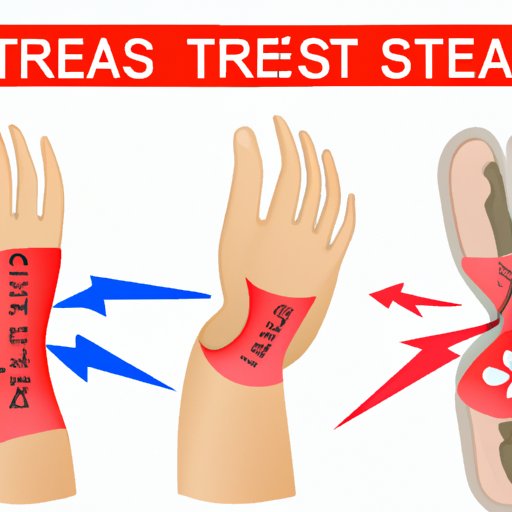
I. Introduction
If you’re a fitness enthusiast, athlete, or someone who loves engaging in physical activity, you’ve probably heard of stress fractures. These are tiny cracks or fissures in bones that develop over time due to repeated pressure and strain. While stress fractures may seem like minor injuries, they can cause significant discomfort and, if left untreated, may lead to more severe complications. Understanding the causes, mechanisms, and treatment options for stress fractures is crucial in preventing further injury and getting back to your routine as quickly and safely as possible.
II. Common Activities that lead to Stress Fractures
Stress fractures can affect anyone, regardless of their age, gender, or fitness level. However, some activities that involve repetitive impact can put you at higher risk. Here are some common activities that may lead to stress fractures:
A. Running
Runners are more likely to develop stress fractures due to the repeated impact that affects the lower legs, feet, and hips. The risk may increase when runners increase the intensity, duration, or frequency of their runs without taking adequate rest periods.
B. Dancing
Dancers often engage in high-impact movements that put significant pressure on their bones and joints. The repetitive bouncing, jumping, and landing can cause stress fractures in the feet, shins, or hips.
C. Weightlifting
Weightlifting puts stress on the bones and muscles, especially when lifting heavy weights or performing the same exercises repeatedly. Stress fractures may occur in the spine, hands, feet, or hips due to the accumulated pressure.
III. Biological Mechanisms Behind Stress Fractures
Stress fractures result from an imbalance between the bone’s formation and resorption processes. When bones undergo repeated mechanical stress, they activate the remodeling process, which involves breaking down old bone tissue and replacing it with new ones.
A. Bone remodeling
Bone remodeling is a natural process that keeps bones strong, healthy, and responsive to changing needs. However, when the remodeling rate exceeds the repair rate, the bones are more susceptible to fractures, especially if the mechanical stress is ongoing.
B. Overuse Injuries
Stress fractures are a type of overuse injury, where the repetitive stress exceeds the bone’s capacity to adapt and repair. Overuse injuries can occur in any bone that is stressed beyond its normal limits, leading to strain, microdamage, and eventually fracture.
C. Impact of high-impact sports
High-impact sports, such as running, jumping, and weightlifting, can increase the risk of stress fractures due to the repeated, sudden, and intense motions that affect the bones and joints. Athletes who engage in these activities frequently may develop microtraumas that weaken the bones and make them prone to fractures.
IV. Risk Factors for Developing Stress Fractures
While anyone can develop stress fractures, some factors may increase the risk of developing them. Here are some common risk factors:
A. Low Bone Density
People with low bone density, such as those with osteoporosis or an eating disorder, may have weaker bones that are more prone to fractures. Women and older adults are also at higher risk of low bone density.
B. Sudden Changes in Activity Level
If you increase the intensity, duration, or frequency of your workouts too quickly, your bones may not have enough time to adapt and repair. This can lead to excess pressure and strain that result in stress fractures.
C. Poor Footwear Choices
If you wear shoes that don’t provide enough support or cushioning, your feet and lower legs may absorb more impact than they can handle. This can lead to stress fractures, especially if you engage in activities that involve a lot of running, jumping, or lateral movements.

V. Importance of Proper Training and Technique
Preventing stress fractures is possible through proper training, technique, and conditioning. Here are some tips that can help:
A. Preventing stress fractures in high-impact sports
If you engage in high-impact sports, such as running or dancing, make sure to gradually increase your intensity, duration, and frequency over time. Take adequate rest periods to allow your bones to adapt and repair, and cross-train with low-impact activities to reduce the overall strain.
B. Role of warm-up and cool-down exercises in preventing injury
Before engaging in any physical activity, make sure to warm up your muscles, joints, and bones to prepare them for the demands to come. Likewise, after your workout, engage in some cool-down exercises to reduce inflammation, soreness, and stress.
VI. Identifying a Stress Fracture
If you suspect that you have a stress fracture, it’s important to seek medical attention early on to prevent further injury. Here are some warning signs and symptoms to watch out for:
A. Warning signs and symptoms
Stress fractures may cause pain, tenderness, swelling, or redness in the affected area. The pain may worsen during activity and subside during rest. You may also experience stiffness, limited range of motion, or weakness in the nearby muscles.
B. Importance of seeking medical attention early on
If you notice any symptoms of a stress fracture, see a doctor as soon as possible. They may order imaging tests, such as X-rays or MRIs, to determine the extent and location of the fracture. They may also recommend a course of treatment, depending on the severity of the injury.
VII. Treatment Options for Stress Fractures
Resting the affected area is the most important part of the healing process. Depending on the severity of the fracture, your doctor may recommend one or more of the following treatments:
A. Rest
Avoid any activities that aggravate the injured area, and rest as much as possible. You may need to use crutches, braces, or casts to immobilize the area and prevent further stress.
B. Immobilization
Your doctor may recommend using a walking boot, cast, or splint to keep the affected area still and promote healing. The duration of immobilization may vary depending on the severity of the fracture.
C. Physical Therapy
Once the fracture has healed, your doctor may recommend physical therapy to help you regain strength, flexibility, and range of motion. Physical therapy may also help prevent future injuries.
VIII. Relationship Between Stress Fractures and Nutrition
Nutrition plays a vital role in promoting bone health and preventing stress fractures. Here are some ways to keep your bones strong and healthy:
A. Role of Vitamins and Minerals in Promoting Bone Health
Calcium, vitamin D, and other minerals are crucial for strong bones. Make sure to consume enough dairy, leafy greens, nuts, and fortified foods to get your daily dose of bone-strengthening nutrients.
B. Adequate Hydration to Promote Bone Strength
Water is essential for bone health, as it helps transport minerals to the bones and facilitate their uptake. Make sure to drink enough fluids, especially if you engage in high-impact activities that increase your fluid loss.
IX. Conclusion
Stress fractures are common injuries that can affect anyone, regardless of their fitness level or activity choices. Understanding the causes, mechanisms, and treatment options for stress fractures is crucial in preventing further injury and promoting a speedy recovery. By following proper training, technique, and nutrition, you can reduce your risk of developing stress fractures and get back to your routine with confidence.
A. Recap of the key points
Stress fractures are tiny cracks or fissures in bones that develop due to repeated mechanical stress. Anyone can develop stress fractures, but some factors may increase the risk, such as low bone density, sudden changes in activity level, and poor footwear choices. Proper training, technique, and nutrition can prevent stress fractures and promote healing. Early diagnosis and treatment are crucial in preventing further injury and complications.
B. Tips for preventing stress fractures
- Gradually increase the intensity, frequency, and duration of your workouts
- Take adequate rest periods to allow your bones to adapt and repair
- Cross-train with low-impact activities to reduce the strain
- Warm up and cool down before and after your workouts
- Wear proper footwear that provides adequate support and cushioning
C. Encouragement to address the problem early on
If you suspect that you have a stress fracture, don’t wait until it becomes a more severe injury. Seek medical attention early on and follow your doctor’s advice to promote healing and prevent further damage. Remember, prevention is always better than treatment.




